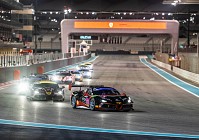The “T” in California T stands for turbocharged, but there are many alternatives. Terrific. Tremendous. Thrilling. No matter how you choose to describe Ferrari’s turbocharged Cali, one thing sets it apart from the other Prancing Horses in the stable: it’s an everyday Ferrari.
The 2015 California T is Ferrari’s latest incarnation of the California, a model that copped global criticism from Ferrari tifosi when it launched in 2008, but ended up being the biggest-selling V8 Ferrari in history. After silencing the critics with the success of its first “daily driver”, and luring a reported 70 percent of new customers, Ferrari then went on to unveil the California T last year, creating a curvy convertible GT and replacing the naturally aspirated 4.3-litre V8 engine with a smaller 3.9-litre unit enhanced by a pair of turbochargers.
Boosting the horsepower and torque wasn’t simply to placate the critics, however. The turbochargers – which blow more air into the engine, burn less fuel and emit less carbon dioxide – meet America’s strict Corporate Average Fuel Economy (CAFE) requirements. For Ferrari – known for its fast and thirsty cars – it’s one of the only ways to meet emissions laws without compromising on performance or the design that makes the cars so (incredibly) desirable.

Though spewing less toxins into the environment might not be a number one concern for supercar owners, even the wealthiest drivers have more than a passing interest in their car’s gas-guzzling tendencies. With the California T, fuel consumption has improved 15 percent making a trip to a service station less frequent, despite the car punching out a colossal 49 percent more torque in 7th gear.
Using 10.5 litres per 100 km, it gives the car the not-so-glamorous title of being rather economical. Essentially, Ferrari has managed to transform a pleasure machine into an everyday driver, which might not sound sexy, but in California T’s case, the car is exactly that. Fitted with Ferrari’s classic accoutrements, the Cali is every inch the head turner, with a sporty grille and sculpted curves.
The look, feel and heavenly smell of the stitched, high-grade leather in the cabin is a delight, with plenty of room to stow away essentials in the glove box, the signature F1 bridge or the armrest compartment, which also features USB ports. It’s all so practical; yet Ferrari, as always, manages to wrap it up in a highly desirable package, thanks to the Ferrari Styling Centre working in collaboration with historical design partner Pininfarina, a pairing that has inspired petrol heads to kiss their fingertips since 1951.

Speaking of fingertips, every conceivable function can be operated at the touch of a finger with the Human-Machine Interface. With F1 paddles within index finger reach, the push-button indicators, a manettino dial (which has three modes: Comfort, Sport and ESC Off, which turns off all stability and traction control), and windshield wipers are all fitted into the arms of the steering wheel, a good-looking circuit of black leather, red stitching and gorgeous carbon fibre. The horn buttons sit neatly beneath either thumb.
But enough about appearances. How does the thing drive? Ferrari buyers expect something fast, furious and forceful and the torquey kick of the Cali’s turbocharged engine doesn’t disappoint. Traction is superb, the car accelerating around 8.5 percent faster out of corners. Brembo’s carbon-ceramic brakes are now standard, the pad and disc revised to last “more or less” for the car’s entire life.
I’m sorry to say I was given strict instructions not to press the enticingly named “launch” button, but it could have been fun. Lots of fun – propelling the car to sprint to 100 kph in a mere 3.6 seconds flat (and on to 200 kph in 11.2 seconds). Perhaps another time?
Once you’re off, you could crank a little Andrea Bocelli to get into the mood, but there’s really only one dulcet, unfiltered Italian baritone you want to be listening to while driving a Ferrari. Some Ferrari cognoscenti have bleated that the Cali T doesn’t rev with the same fury as a naturally aspirated Ferrari engine, but ignore the purists; the satisfying rumble well and truly inspires emotion – not to mention raises the hairs on the back of your neck.

A neck that, by the way, will be comfortable. Ferrari spent a great deal of time crafting the T’s seats with new shapes, foams and fixed headrests integrated into the backrest. With two riding, it’s unquestionably comfy. Another two passengers could sit snugly in the rear seats, which have been reconfigured slightly to allow for more leg room, however they are best reserved for those under four feet, or as Ferrari freely admits: “two adults on shorter journeys”.
Much of the boot space is taken up by a spare tyre and a Ferrari kit, though the rear seats fold down if you really must squeeze in the golf clubs. If you want the sensation of more room simply retract the roof. The one-touch manoeuvre is a smooth transition provided the car is immobile, and it takes a meagre 14 seconds. With the roof on, it’s a quiet journey, but drive with the top down, and the California T’s soundtrack is audible in its full glory.
As you accelerate, feeling your head pinned back and the wind in your hair, there’s little to complain about. Believe me, I tried, and the only grievance I could raise was that the steering wheel slightly obscured the indicator arrows on the display. In summary, I’m a happy driver. Red, fast and a hell of a lot of fun – it’s Ferrari to a T.
Nuts & bolts










